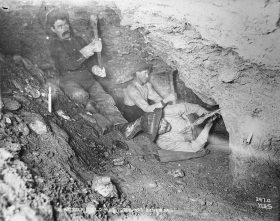YUKON TERRITORY 1897
1 The Klondike gold rush began in July of 1897 when two ships docked in San Francisco and Seattle carrying miners returning from the Yukon with bags of gold. The press was alerted and papers carried the story to the masses.2 Soon, miners of all shapes and sizes, called "stampeders," were on their way to the gold fields. Within six months, approximately 100,000 gold-seekers set off for the Yukon. Only 30,000 completed the trip.
3 Most stampeders knew little or nothing about where they were going, so pamphlets were available to help them on their way. Many of the pamphlets contained little or no real information and made outrageous claims of wealth to be had by everyone. Outfitters sprang up overnight that were happy to sell the stampeders whatever they needed to get started. This included food, clothing, tools, and camping, mining and transportation equipment. Helping the outfitters in this regard were the Northwest Mounted Police who required all stampeders to have one year's supply of goods before they allowed them across the border into Canada. This was roughly one ton of goods per person. Towns such as Seattle made fortunes outfitting the miners.
4 The easiest and more expensive route to the gold fields was by boat upstream from the mouth of the Yukon in western Alaska. The most difficult route was the "All Canadian Route" from Edmonton and overland through the wilderness.
5 The most common route taken by the stampeders to reach the fields was by boat from the west coast of the continental U.S. to Skagway in Alaska, over the Chilkoot or White Passes to the Yukon River at Whitehorse and then by boat 500 miles to Dawson City.
6 The Chilkoot Pass trail was steep and hazardous. Rising 1,000 feet in the last 1/2 mile, it was known as the "golden staircase": 1,500 steps carved out of snow and ice worked their way to the top of the pass. Too steep for packhorses, stampeders had to "cache" their goods, moving their equipment piecemeal up the mountain. Stampeders who gave up often did it here, discarding their unneeded equipment on the side of the trail.
7 Conditions on the White Pass trail were even more horrendous. Steep, narrow and slick, over 3,000 pack animals died on the trail causing it to be dubbed the "Dead horse trail."
8 Those who made it across the passes found themselves at Bennett Lake. Here, boats had to be built to run the final 500 miles down the Yukon River to the gold fields. A three week trip, the miners had to survive many sets of rapids before making it to Dawson City. Many miners lost their lives or their possessions when their boats broke up in the rapids.
9 Those who survived the perilous journey mostly found disappointment once they reached Dawson City. Locals had already claimed all of the gold-bearing creeks and claims of "gold for the taking" were grossly exaggerated. Many stampeders headed home, some worked for others on the claims, and still others stayed to work in Dawson City.
10 The work that was necessary to retrieve the gold was incredible. Most of the gold was not at the surface, but rather 10 or more feet below. To reach it, the miners had to dig through the permafrost - the layer of permanently frozen ground. The ground had to be thawed before it could be dug. Then the dirt had to be sluiced to separate it from the gold. All digging had to be done during the summer as it was impossible to dig in the winter when temperatures could reach -60 degree F. It was incredibly difficult work.
11 The biggest boom to hit this part of the world was a huge bust for the miners. The only ones to strike it rich were the merchants and profiteers who took advantage of those who hoped to "get rich quick.





